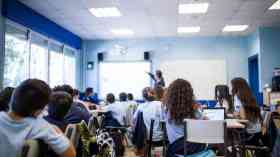Learning through play

It is interesting to see how far our education system has changed within a single generation. The small village school with wooden desks and blackboard dusters has evolved into a place of interactive learning governed by those ever-present Ofsted ratings. The theories behind how children learn have come a long way as well. To an old fashioned Victorian school, learning and playing were no doubt seen as two separate activities. Today, however, learning through play is promoted within early years education as an important teaching practice. Thrilling as it would be to discuss different teaching strategies through the ages, it is, perhaps, more relevant to see how this has impacted the landscapes within our schools.
Guidance on outside space
With the pressure of Ofsted inspection laying down expectations and requirements for learning and learning facilities in schools, landscape contractors are increasingly being contacted by schools who want advice and guidance on their outside spaces. We are often greeted by a square of black tarmac, sometimes accompanied by an area of grass that cannot be used in the winter, or a poorly thought out space that is not being fully utilised. It is clear, when we begin asking questions, that they are very keen to use their outside space and have clear ideas of what they need.
Common requests are for water play, a covered outside classroom, adventurous and risk play areas, garden and growing areas and cycle tracks. It seems that playgrounds are no longer just places into which teachers usher children at various points in the day to amuse themselves whilst they have a rest. These spaces are now being viewed as an extension of the classroom. This does, however, present a challenge for schools in terms of budget, the space they have available and how to order their area to get the best from it.
As a specialist landscape contractor we like to take an holistic approach and offer a bespoke design service because we believe that one size doesn’t always fit all and a unit-based solution doesn’t offer the most inspiring play area or use the available space wisely. Although our design themes often stay the same, they are easily scaled up or down depending on space and budget and if there are any existing features like trees and banks, we use them to our advantage.
A particular design idea at a school with trees was based on the tree top canopy walkway at Kew Gardens. Scaling the idea down to work in a school worked brilliantly as it got the children up in the trees (1.5m high) and created a sense of adventure. Adding to this a climbing wall, access ramp, scramble net, steps and artificial grass slide provided a challenging environment for reception children, promoting upper body strength and small motor skill development at various wooden leaf carved rubbing points hidden on the structure. Themed as the Enchanted Forest, with an all-weather rubber safety surface, it was the ideal place for playing but could also be used by teachers for themed learning for science, role-play and story telling.
What we have found is that children love remarkably simple things but these need to be incorporated within good design and planned space. Ideas based on real concepts are brilliant as this also goes towards teaching children of world realities and also gets their parents onboard.
Providing an exciting space
So is it worth the cost, and do outside areas noticeably contribute towards learning? Everyone will have their own thoughts on the matter but one could reasonably argue that a blank piece of tarmac is the perfect place for a kick-about and for forcing children to use their imagination in the absence of anything that is likely to stimulate it. However, I believe that you get out what you put in. If you provide an exciting space that presents challenge and risk, children will learn from their mistakes. I guess the older generation would call it learning the hard way! I also think that you could assume that making learning fun provides motivation, and having the chance to be outside actively doing something in a lesson rather than interacting with a white board would, to me, seem far more beneficial. And maybe there is a sub-conscious benefit of simply being physically and psychologically active outside leading to greater concentration and motivation inside the classroom.
Whatever you think, schools are being judged and scrutinised now more than ever about what facilities they are offering to children to fulfill learning criteria in the early years curriculum and this provides a great chance for landscapers to be creative and help in providing teachers with fantastic, unique outside spaces.
Further information
Roy Nicholls is contract manager at Baylis Landscapes, which is a registered members of the British Association of Landscape Industries (BALI). For information on the Association, or to
find a BALI Registered landscape designer or contractor, visit www.bali.org.uk or call 024 7669 0333
Latest News
14/11/2025 - 11:04
England’s councils are warning of a "ticking time bomb" in the special educational needs and disabilities (SEND) system, with new data showing deficits that could bankrupt local authorities within three years.
13/11/2025 - 12:14
Event for school leaders, governors and education professionals relocates to the historic Old Billingsgate venue in London.
13/11/2025 - 09:49
The regulations have been set following a second consultation and detailed collaborative working with organisations and people across deaf and hearing communities.
13/11/2025 - 09:39
The Education Committee has published a letter to the Secretary of State for Education asking for more detail about the Department for Education’s work on developing its SEND reforms.
13/11/2025 - 09:26
New analysis by NFER has highlighted the uneven distribution of pupils with special educational needs and disabilities (SEND) across mainstream schools in England.







